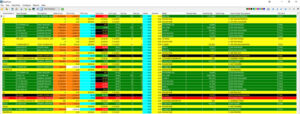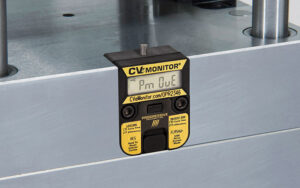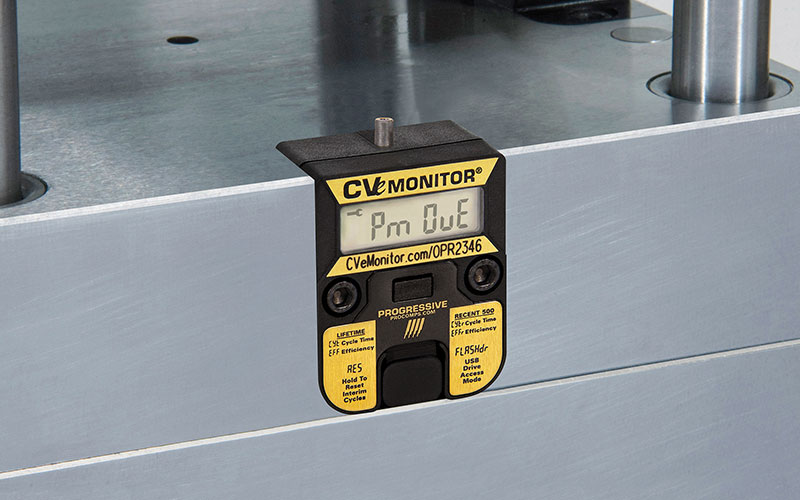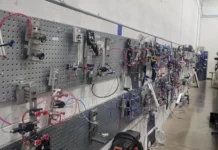by Hallie Forcinio, writer, Plastics Business
Automating sales, scheduling, mold tracking and mold qualification processes saves time, reduces staffing demands, improves accuracy and efficiency and can increase profitability.
Automation involves a combination of hardware and software. It frequently resides on the production floor and generates a host of benefits: Boost productivity and efficiency; improve accuracy; and save time, labor and cost. The results positively impact profitability. So, it’s not surprising automation can deliver the same benefits to non-production processes such as sales, scheduling, mold tracking and mold qualification.
Automating the sales process

Automating the sales process relies on customer relationship management (CRM) software. The CRM system serves as a hub to generate and manage leads, monitor sales in the pipeline and analyze win/loss data. The result is a lower cost of sales and a reduction in resource requirements.
“Automating the sales process helps salespeople focus on active selling opportunities, offers a higher probability to close sales, identifies the most profitable and long-term opportunities and eliminates manual tasks that could require double the time and effort,” said Todd Zielinski, CEO at Athena SWC, a provider of outsourced sales support. This is accomplished by tracking “touches” with the customer or prospective customer and centralizing the information.
Software can reside in-house or be provided as a service. The software can be a standalone program or a bolt-on function for an enterprise resource planning (ERP) or other system. Scott Hill, account manager at Athena SWC, favors standalone programs, which generally integrate easily with ERP systems, cost less and are more functional and user-friendly than bolt-on CRM modules.
Benefits of CRM include reduction in repetitive tasks, faster outreach, ability to reach a bigger target market, more efficient communication with a larger number of prospective customers, prioritization of contact management and elimination of silos of information. “Reminders can be set for calls and meetings,” said Hill. And email automation software, which can be integrated with CRMs, can be programmed to generate communication with customers. “Drip” campaigns can be automated, where email is sent when triggered by a certain behavior of a prospective buyer, such as visiting a web page. Lisa Benson, senior marketing content consultant at Athena SWC, explained, “This is more complicated to set up. You have to plot out what communication should happen when. A lot of content is required.” Most systems also include a scoring system that observes prospective customer behavior to qualify prospects.
Most importantly, automating the CRM process means decisions are made on data – not gut feelings. “Numbers don’t lie,” said Zielinski. “It allows a company to be very targeted in its sales efforts. If done properly, the sales data can be used for forecasts and tie into production and staffing needs. You not only know where the sales opportunities are but what machines will be needed, so the right resources are in place based on what’s in the pipeline,” he concluded.
Companies seeking to implement CRM should plan for an implementation schedule ranging from about 30 days to six months, depending on the complexity and size of the organization, the amount of data and the number of sales personnel. Prior to implementation, a business should take the time to understand the steps in its sales cycle and what visibility is needed. Implementation involves ensuring lists of potential customers are clean and complete, determining a schedule of activities and identifying results to be monitored. Questions to be answered include: How will the database be set up? How will it be searched? By industry? By sales representative? By geography? What customization is needed to fit the business?
Successful CRM projects depend on an in-house administrator who knows how to run the system. “We help as needed,” said Hill, which may include providing an Athena SWC staff member to serve in the administrator role. Implementing a CRM system also requires attention to onboarding and training. He advised, “Make sure reps buy in. This typically is the hardest step. Most salespeople look at software as a hindrance. Put rules in place that the system must be used to enter orders, track history, etc.”
Hill also warned against over-customizing the software to the point it becomes like a proprietary system that will cost a fortune to upgrade. Another caveat is to avoid using the generic templates most programs provide for email marketing. “Lack of personalization can turn off customers,” he explained.
Automating the scheduling process

With today’s supply chain, demand planning and labor constraints, production scheduling needs to be as efficient as possible. One way to boost efficiency is to convert paper- and spreadsheet-based worksheets to an automated scheduling process. The primary benefits of automated scheduling include greater flexibility in prioritizing and scheduling orders and “as it happens” visibility of all orders in process. The greater the shop floor visibility, the greater the opportunities to increase productivity. Implementation is relatively quick, ranging from three to 12 months, depending on the size of the organization and number of locations involved.
Scheduling software may be standalone or part of an enterprise resource planning (ERP) or manufacturing execution system (MES). Manufacturing scheduling and planning software from DELMIAworks, which is a part of the 3DEXPERIENCE Works portfolio from Dassault Systemes, is the latter. The scheduling and planning modules are part of the company’s integrated ERP/MES, which run on the same database, ensuring end-to-end visibility across production. Functions include forecasting, production planning and organization of materials and resources to minimize lead time and ensure all product and packaging components, whether manufactured in-house or outsourced, are present when needed to run a job.
The module also supports material requirements and resource planning, master production schedules, an advanced planning and scheduling system and Capable-to-Promise (CTP) function, which also contributes to greater end-to-end visibility. CTP is especially useful for updating customers about ship dates, as this feature automatically checks the raw material, machine tool, scheduling slots and impacts and labor availability needed to complete an order. “For small and mid-tier manufacturers who often are part of broader supply chains, being able to accurately predict when they’ll have a customer’s order done based on constraints is golden,” said Louis Columbus, senior industry marketing manager at DELMIAworks.
DELMIAworks’ manufacturing scheduling and production planning software provides an interactive drag-and-drop graphical screen interface that displays every order or task status and each work center’s status in real-time. Everyone on the shop floor can check the screen any time, often from large, flat-panel monitors mounted over the shop floor. Any member of the production team can learn what job is on deck, how it fits in with other jobs and what they need to do. “Everyone on the shop floor now is in sync,” said Columbus.
When everyone sees the performance metrics and knows what’s going on, companies are more adaptable and employees are less stressed. Forecasting and production planning improve, and chaos recedes. “It brings greater stability into daily manufacturing operations and contributes to a smoother, more consistent production cadence because every team knows how what they’re doing helps other teams,” noted Columbus.
DELMIAworks’ real-time production and process monitoring automatically updates the ERP, MES and related manufacturing modules, enabling continuous process improvement based on insights gained from machinery and process-based data. “With real-time production monitoring, manufacturers most often count production cycles, measure scrap, ensure all production steps are executed, measure production times and predict completion times,” said Columbus.
Capitalizing on the insights gained from production and process monitoring using Statistical Process Control analysis and similar quality management techniques, manufacturers discover how they can take action and improve metrics over time. Automated scheduling also is more accurate based on the data-driven lessons learned. Key metrics – including demand forecast accuracy; fill rate effectiveness as a percent of all orders; gross contribution margins by product and production facility; inventory carrying costs; inventory turnover; order cycle times and order pick; and pack and ship accuracy – improve when manufacturers use production and process monitoring as a feedback system. Customer satisfaction goes up, driving down Days Sales Outstanding (DSOs) on invoices because product quality meets or exceeds expectations.
The more efficient and responsive production scheduling is, the more a manufacturer can differentiate itself. Knowing the constraints that must be considered when scheduling a production run and committing to a delivery date is a competitive advantage. Columbus explained, “Given how customers’ expectations have been set by the leading e-commerce sites to expect split-second responses to their order status and inquiry requests, manufacturers need to excel at this to grow.”
Automating mold tracking

Automating mold tracking also depends on data and can take several forms. It starts with data collection that makes it possible to view and analyze real-time information. The types of data captured include cycle counts, cycle times, preventive maintenance (PM) adherence, rejects/downtime and other information, which can be used to calculate key performance indicators like Overall Equipment Effectiveness (OEE). Resulting reports and dashboards provide the information needed to make business decisions and understand exactly what’s happening on the molding floor.
Another aspect of the mold tracking process is managing assets – and identifying their locations. This can be done with QR codes. Glenn Starkey, president and director of engineering at Progressive Components, said, “This knowledge is critical as tooling often is spread across the globe and not always tracked as it moves.”
Implementing mold tracking is not an all-or-nothing process. It can start with as little as capturing cycle counts and build from there. In most operations, counts already are gathered using a mechanical counter. Adding a CVe Monitor from Progressive Components makes it possible to collect data as operations take place. Complimentary OnDemand software generates reports showing utilization, cycle time, efficiency and overall production metrics. Transitioning to the next step, the Cloud-based CVeLive offers real-time data access from anywhere in the world to monitor production and molds and provide complete visibility of all tooling.
“Although implementation may seem daunting, with today’s plug-and-play systems, installation is simple and straightforward,” said Starkey. Training can be done remotely, and data that’s gathered is available to any staff member who needs it. “Overall,” he continued, “we support every facet of the installation, training and ongoing usage of the system to simplify it and make it feasible for the customer.”
Automation delivers remote visibility to action on the production floor, improves accountability and supports adherence to PM schedules. Manual processes are only as good as the information that’s input and the frequency at which the data is entered. With manual processes, the data being reviewed are already old and often reflect a problem that has been occurring for some time. By automating manual processes, data can be accessed immediately as it is collected, and decisions or adjustments can be made as soon as an issue arises, potentially saving hours and preventing costly waste.
“Tooling is our most valuable asset in manufacturing and needs to be maintained at very specific intervals to ensure maximum output and efficiency,” explained Starkey. “Automating these processes and implementing a system that helps adhere to these schedules is critical to overall business continuity and has a direct impact on the bottom line.”
As with automating the sales and scheduling process, the biggest pitfall to automating mold tracking is the fear of change and employee engagement. However, these challenges can be overcome with a phased implementation paced at a rate that makes the workforce comfortable with the change and provides time to buy in to the benefits of the system. This phased approach also alleviates some of the short-term stress induced by the learning curve.
Automating the mold qualification process
Multi-cavity molds for injection molding machines go through an extensive qualification process before being put into production. Trial parts are made and carefully examined to fine-tune the design. Traditional methods involve cutting, polishing, microscopic examination, optical comparators and coordinate measuring machines, requiring multiple trials and typically consuming four or five weeks before the mold is ready for production. In the meantime, the machine center for the mold being qualified is not available for other work.
Replacing this largely manual process with an industrial computed tomography coordinate measuring machine (CT-CMM) condenses the mold qualification process to less than five days. The purpose-built xray-based Metrotom CT scanner from ZEISS Industrial Quality Solutions captures the part’s dimensional data and creates a digital twin that can be stored and recalled at anytime from anywhere. This information speeds decision making and can flag problems that may not have been apparent otherwise.
The CT-CMM offers capabilities beyond dimensional verification, including checking the integrity of the material and for the presence of air pockets. In overmolded assembly applications, the technology can validate how parts come together. It can confirm all areas of the mold are performing optimally and that parts from one cavity are equivalent to those from another cavity. It also can check for tool wear and provide an alert if a mold repair is needed.
The equipment is color agnostic and performs equally well on transparent, translucent, opaque and tinted parts. “Color is an issue for most measuring equipment,” noted Kevin Legacy, head of X-Ray North America at ZEISS Industrial Quality Solutions. “To be detectable by the sensors on traditional equipment, transparent and translucent parts must be pre-coated, a process that adds cost and time to the validation process,” he explains. Perhaps best of all, the testing is non-destructive; there’s no need to cut up parts.
The result is dramatic improvement in the bottom line. Faster validation means molds are shipped to customers more quickly, floor space and machining capacity are freed up and more tools can be made without adding resources. “In fact, with machining centers no longer tied up for weeks waiting for a mold to be validated, it’s possible to double mold production,” said Legacy. Faster shipment also means quicker payment.
With a CT scanner, the time required to return an existing mold to production is similarly reduced. The machine makes a part-to-part comparison using color mapping that shows what the part looked like before the mold was removed from the machine and what it looks like after it was put back in place. “If the comparison shows nothing has changed, the mold is ready for production,” reported Legacy.
CT systems can be installed and operational in two or three weeks. He noted, “We have a really good e-learning program so training can be done remotely. It’s not a 100% replacement for in-person training, but it allows operators to study when it’s convenient and at their own pace.” Further simplifying training and operation is the integration of the same Gom software, interface and programming method used on the company’s optical scanners.
When installing a CT-CMM, Legacy stressed the importance of education. He explained, “The word ‘xray’ can stir fear. It’s essential that workers understand that machine construction and operation follow stringent state and federal safety specifications.”
He added, “Most customers with newly installed CT systems wish they had made the investment years ago. Results are immediate. It delivers information no other device can provide. With more information, they can make molds that produce better parts, fine-tune wall thickness and improve porosity.” However, for those not ready to make the investment in a machine, ZEISS offers CT scanning services at its country-wide network of metrology labs.





